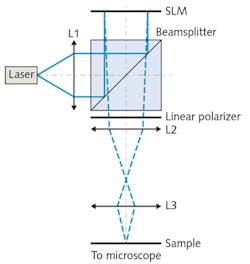Optogenetics/Neuroscience: Digital holographic lighting enables human neural-network research

Thanks to advanced imaging techniques, brain research has made great progress in recent years. Still, understanding of connectivity in neural networks remains a major challenge in neuroscience. Neural networks cultured from human-induced pluripotent stem cells provide a powerful platform for enabling such research. And tagging with optogenetic proteins enables functional control of these networks at spatiotemporal resolution not possible with electrical stimulation—the standard modality for such studies.
But while the full-field illumination normally used in optogenetics research can mask important functional information, digital holographic illumination can reveal such details to enable greater understanding.
Optogenetics with holographic illumination
Researchers from the Technische Universität Dresden (Dresden, Germany) have explored the application of holographically shaped illumination to optogenetics for use in neural-network studies. The setup they have devised enables stimulation of single neurons with high spatiotemporal resolution (about 8 µm spatial and <0.6 ms temporal). The team, made up of scientists in the Electrical and Computer Engineering department’s Laboratory of Measurement and Sensor System Technique and the Center for Regenerative Therapies Dresden (CRTD) at the TU Cluster of Excellence, used its approach to record single-cell stimulation of human neurons within random networks. The work lays the groundwork for further study of connectivity in such neural networks.
The team’s holographic illumination setup (see figure) uses a lens to collimate 450 nm light, generated by a single-mode laser diode, to >20 mm diameter. A nonpolarizing 50:50 beamsplitter then reflects that light, while a ferroelectric liquid crystal (FLC) over silicon spatial light modulator (SLM) provides modulation. A linear polarizer provides conversion to binary phase-modulated light. Finally, a Keplerian telescope demagnifies the specimen before the modulated light adaptively illuminates it. A camera mounted on a commercial inverted microscope captures illumination of the specimen. The specimen that the researchers observed is a two-dimensional random network of human neurons, derived from induced pluripotent stem cells, placed on a multielectrode array.
The team notes that the FLC-on-silicon SLM is indispensable for simultaneously steering multiple focal points. The hybrid technology provides binary polarization modulation up to 2 kHz, and a count of approximately 3 Mpixels at 8.2 µm pixel pitch. While it’s true that microelectromechanical-systems (MEMS)-based digital light processors (DLPs) are faster, the binary phase modulation enabled by the FLC/SLMs enable double the maximum diffraction efficiency.
Computer-generated holograms
The German team is not the first to use FLC over SLM for holographic optogenetic stimulation, but earlier research used a Fourier hologram scheme to control focus, which imposed important limitations—including the number of cells that can be illuminated simultaneously. So, the researchers used free-space computer-generated holograms (CGHs) along with binary Fresnel zone plates to focus laser light to the desired positions. This approach allowed the modulator itself to act as focusing optics.
The researchers’ experiments in stimulating several individual input channels has shown that neurons serve as multithreshold signal switches. Work with more individually controlled inputs promises further insight into neural-network connections, signal pathways, and memory formation.
REFERENCE
1. F. Schmieder et al., Appl. Sci., 8, 7, 1180 (2018); doi:10.3390/app8071180.

Barbara Gefvert | Editor-in-Chief, BioOptics World (2008-2020)
Barbara G. Gefvert has been a science and technology editor and writer since 1987, and served as editor in chief on multiple publications, including Sensors magazine for nearly a decade.